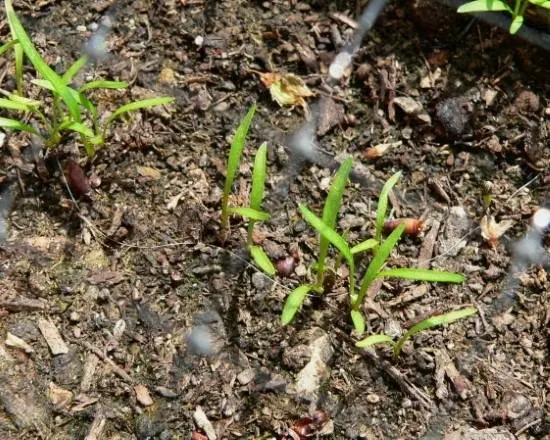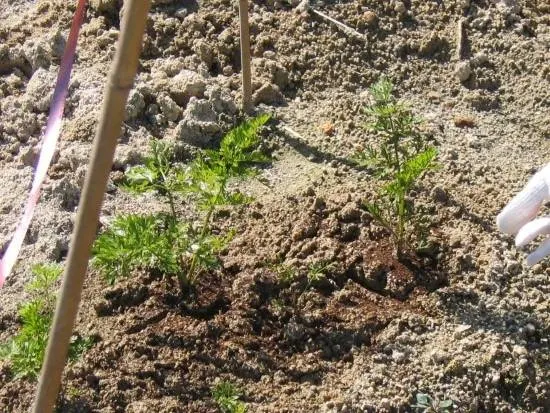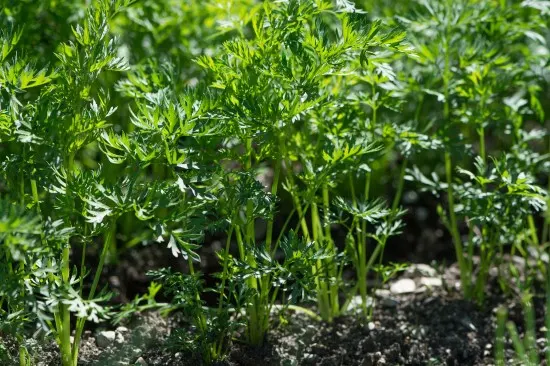Carrots are one of the most common vegetable crops among summer residents. They are valued for their taste and richness with vitamins.
Gardeners prepare very carefully for planting these root crops. For the expectations to pass calmly, it is crucial to know the timing of the seedlings and the conditions that affect them.
The term germination is understood as a certain amount of time elapsed from sowing seeds in the ground to the formation of the first shoots. It depends on many factors, considering which, every gardener will predict the appearance of sprouts in their garden.
And many, just like beginners, ask themselves the question every year: what do carrots look like when they sprout?

What Do Carrots Look Like When They Sprout?
The seed leaves of carrots seem to come from the same place when they sprout. They are generally silky and have a delicate texture.
Also, they look like grass, but the significant difference is that the second blade of grass sprouts from the leading leaf. Various methods are used to distinguish carrot shoots from other weeds or plants. Nevertheless, most of the ways are used in small home gardens. This include:
1. Sniffing the leaf
Pinch part of the leaf and then crush it with the fingernails, then smell it. Typically, carrots smell like real carrots when they sprout. If you discover that its smell differs from a carrot, the sprout could be from another plant or herb in the garden.
2. Wait for real leaf
Growing carrots require you to be patient. If you need to remove weeds but cannot differentiate the carrots that sprout from weed, you need to give them time to produce real leaves. Carrot leaves look like palm leaves.

How to Grow Carrots
1. Soil preparation
It is advisable to plant carrots in well-lit soil. If the carrots do not have enough light, then it loses mass and sugar content. The ground for planting should be light and level. It should also be well-drained, sandy loam, and light loamy.
If the loam soil is dense, the carrots will be small, and during storage, they will be quickly affected by rot. You are not supposed to plant carrots on acidic soils.
It is best to choose a neutral or slightly acidic environment. The planting bed must be prepared in the fall so that it is well established.

2. Seed preparation
The germination of carrot seeds is relatively low (60-75%). To increase the yield percentage, it is necessary to sow only fresh seeds.
The first shoots of carrots can be observed as early as 20 days after sowing. Rapid seed growth is ensured by washing off these oils. Therefore, the seeds must be pre-treated.
There are several ways to prepare seeds. Seeds in a tissue bag should be placed in warm water for twenty-four hours. The water should be changed every four hours.
You can also soak carrot seeds in a solution of wood ash. After removing the seeds from that solution, they must be rinsed under running water. To get a good harvest, soaking can be combined with stabbing, which keeps the seed bags in the refrigerator for about four days.
3. Sowing
The sowing date for carrots should always be indicated on the seed bag, but if you grew the seeds yourself or bought them, focus on the correct period.
Carrots for fresh consumption in summer are sown in early spring, as soon as the topsoil warms up and dries up or before winter.
Carrots sowing is suitable only for residents of those regions where winters are not frosty and with heavy snowfalls; otherwise, the seeds will die even under a thick layer of mulch.
It is worth sowing carrots for storage in the second half of May when the air warms up to a stable 15-18 °C, night frosts pass, or on the 20th of June. With such late sowing, the plant is not damaged by the carrot fly.
4. Watering
Without watering, carrots become lethargic and bitter, and it negatively relates to both constant under moisture and periodic droughts.
However, it will also not be good with the appearance of the swamp. This culture prefers stability and control so that your carrots do not dry outright in the garden and do not crack from the abundance of moisture.
Make it a rule to water it every 5-7 days to a depth corresponding to the length of the root crop. While the carrots are young and thin, it is enough to soak the soil 5-7 cm, but the fully developed carrots need to be watered so that 30cm from the soil surface is moistened.

5. Fertilizing
It is enough to fertilize carrots twice a season on average soil: the first time three weeks after germination and the second, one month after the first watering. For average growth of the root crop, any of the following dressings are suitable:
- One tablespoon nitrofocks for 10 liters of water
- Two glasses of wood ash per 10 liters of water
- 20 g of potassium nitrate, 15 g of urea, and 15 g of double superphosphate per 10 liters of water
6. Thinning carrots
For the carrots to grow large, the distance between the root crops must be constantly monitored, preventing the plantings from thickening. The first thinning of carrots is carried out in the appearance of the first pair of true leaves, leaving 3 cm between shoots.
7. Diseases and pests of carrots
Most often, carrots are damaged by the carrot fly, which is attracted by the aromatic tops of this culture. Prevention of the invasion is the correct cultivation where you need non-thickened planting and the absence of stagnation of moisture in the soil.
If this does not help and the leaves of the carrots begin to curl, you need to treat the plantings with Alatar, Inta-Vir, Iskra, or Fufanon-Nova according to the instructions. This is the first sign of the appearance of the pests.
The most common types of diseases, which affect carrots include phomosis, sclerotinosis, Alternaria, botrytosis, and bacteriosis. These diseases can be prevented by careful observance of crop rotation and cleaning plant residues from the ridges. But the treatment of each illness is different.
Conclusion
Carrots are root vegetables, which are rich in beta-carotene and vitamins. Many gardeners want to plant them due to their taste and the flavor they bring to different dishes.
The hardest part of growing carrots is to know what they look like when they sprouts. We hope it is easy to know them when planting them in the garden with the tips above.
>> Related Post: What Do Carrot Plants Look Like and What Factors Can Affect It?
